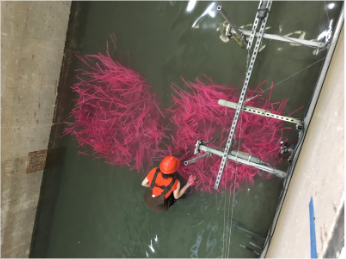Submerged aquatic vegetation (SAV) species native to PNW estuaries, such as the seagrass Zostera marina, are highly valued for their ecological, economic, and cultural services. Unlike reeds, marsh grasses, and other vegetation of interest for coastal engineering purposes, SAV is highly deformable under waves and currents. Because of its dynamic flexible behavior, SAV modification of estuarine hydrodynamics is relatively understudied. We conducted full-scale laboratory experiments to investigate how SAV patches modify wave hydrodynamics to create patch-scale depositional mounds. Experimental results evidence that wave-patch interactions increase within-patch turbulence (TKE), enhance wave velocity skewness, and create shoreward directed mean currents to suspend and transport sediment from within the patch into a shoreward depositional mound. When wave-driven undertow currents are strong, they converge with patch-driven shoreward transport mechanisms; converging sediment transport can lead to as much as a threefold increase in mound volume. Further investigation into these findings are being conducted with a numerical model to determine how larger-scale SAV canopies control sediment convergence in the nearshore environment.

About the Author:
Liz Holzenthal (OSU Ph.D. Student 2015-2022) studied how submerged aquatic vegetation (SAV) alters waves and currents to enhance sediment deposition and minimize shoreline erosion exposure. She is originally from Mandeville, Louisiana and earned her B.S. in Civil Engineering from the University of Notre Dame. At Oregon State, she worked with Dr. David Hill and Dr. Meagan Wengrove to study how SAV contributes to estuarine circulation and large-scale erosion control. Liz is now a researcher with the U.S. Army Corps of Engineers, Engineering Research and Development Center in Vicksburg, MS.


